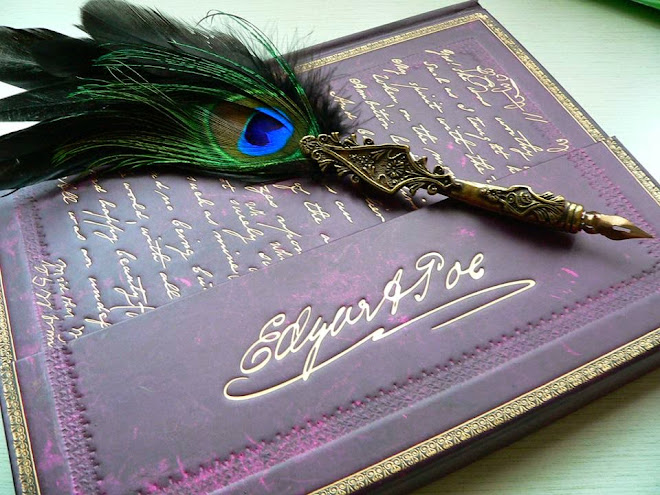Did you notice the amount of gothic pictures featuring violins? Ever wondered why? Well, it appears that violin is connected with the macabre!
Here's for you some very interesting facts I found about this:
"Associations between the violin and death or the devil reside deep in the modern Western consciousness. Traditional, popular, and classical music cultures have reinforced this viewpoint many times over. The identity of the "Devil as fiddler" has evolved in stages over the past two millennia or longer as numerous religious beliefs, folk legends, and literary tales merged to produce a central myth.
Roots of this myth trace back to ancient Greek religious cults. Instruments were commonly associated with specific deities and their ethical attributes. Accordingly, string instruments were thought to possess enormous restorative powers.
This correlation between musical instruments and moral states appealed to early Christians. Medieval society invoked music to rationalize the constant intrusions of warfare, plague, and death. In literature and folk lore, the sound of pipes frequently accompanied Death on his gruesome rounds. During the Middle Ages, string instruments enjoyed quite different affiliations. Ecclesiastical artists commonly selected the soft-toned vielle, rebec, or lira for symbolic representations of goodness and the divine. Saintly figures, angels, and cherubim often held these mellow-sounding instruments in hand. Thus, the ancient Apollonian stereotype was retained for centuries in Western Europe.
The mid-sixteenth-century emergence of a new family of strings, including the violin, changed everything. The violin's popularity grew with enormous swiftness, primarily because of its loud tone and secure tuning.
The earliest artistic renderings of the violin date from the 1570s. In these, peasant performers accompany group dancing, an activity denounced in the afterglow of the Protestant Reformation and Catholic Counter-Reformation. Many writers blamed the Devil for the very existence of dance. The Devil, as the agent of Death and creator of dance, became inextricably linked to the violin during the Renaissance period.
Tales of demonically endowed fiddle players first emerged during the seventeenth century. For example, the eighteenth -century Italian violinist Giuseppe Tartini raised the degree of diabolical intervention with his claims of a dreamy pact with the Devil.
Tales of supernatural contracts between musicians and the Devil proliferated during the nineteenth century, fueled by the immensely popular story of the scholar Faust and his calamitous pact with Mephistopheles. Many people believed the only explanation for Nicolo Paganini's unparalleled violin technique was a Faustian alliance with the Devil. The Italian violinist parlayed this demonic mystique into a phenomenally lucrative concert career. Furthermore, the superhuman virtuoso image- long hair, angular features, sly grin, and slender figure- originated with Paganini.
Condemnation of the violin as an instrument of the Devil spread during the nineteenth century to other parts of Europe and North America.
The relationship between the Devil and string music has resurfaced in recent popular music. Bluesmen believed that if a guitarist reached the crossroads at midnight, he would receive supernatural virtuosic abilities in exchange for his soul. Early blues-inspired rock artists- among them the Rolling Stones, Cream, and Led Zeppelin- perpetuated this mystical aspect. Heavy metal artists consciously adopted Paganini's nineteenth-century virtuoso image in their powerful stage presence, styles of hair and clothing, and musical pyrotechnics. The electric guitar provides a modern high-voltage equivalent to the violin.
No contemporary song better illustrates the persistence of the "Devil as fiddler" than the 1979 country-rock hit "The Devil Went Down to Georgia" by the Charlie Daniels Band. The Devil encounters a young man "who plays the fiddle hot" and challenges him to a musical duel, the outcome of which is unexpected: After centuries of bargaining, humankind has finally produced a musician whose natural skills surpass the Devil's.
Four symphonic poems lie buried within the enormous orchestral catalogue of French composer, organist, and pianist Camille Saint-Saens (1835-1921). The first, second, and fourth drew their inspi- ration from the mythological accounts of Omphale, Phaeton, and Hercules. The third, however, corresponded to a contemporary poem by Henri Cazalis (alias lean Lahor). These verses, quoted above, tell of a frenzied demonic dance that takes place after the stroke of midnight- the witching hour. Saint-Saens completed his Danse macabre in 1875 and published the score a year later. He also made several arrangements, including for violin and piano and for two pianos.
Some orchestral players rebelled against the literal representation in Danse macabre and only reluctantly participated in the premiere at a February 3, 1875 program of the Concert National under Edouard Colonne. The critic Adolphe Julien complained that the piece "has everything but a musical idea, good or bad." He continued by describing it as either "an aberration or a hoax." Audiences, on the other hand, took enormous glee in the fiendish orchestral score. The bells toll midnight on All Hallow's Eve. Death, playing an oddly mistuned violin, summons skeletons (depicted in the orchestral version by the rattling "bones" of a xylophone) from their graves to dance a macabre waltz- an ominous parody of the Dies irae chant from the Mass for the Dead. These spectral figures dance until the rooster crows dawn, then they return to their tombs until the next year."


♥























2 comments:
...I...love...this. I've ALWAYS LOVED VIOLINS~!
I used to be a violinist, from age 7 until 23. Sadly, I developed carpal tunnel syndrome in my right wrist and was forced to abandon music school. Luckily, I work in an academic music library, so the music is still a big part of my life. :)
I never attempted the Tartini-incredibly difficult!
Post a Comment